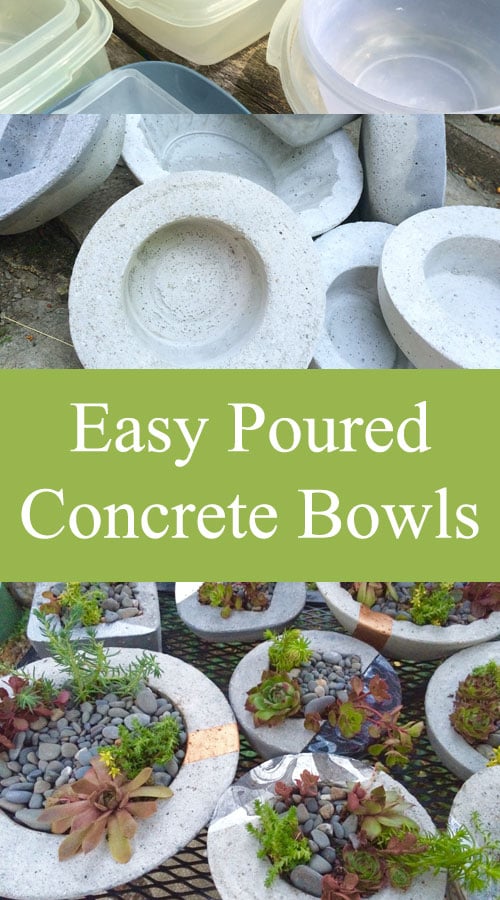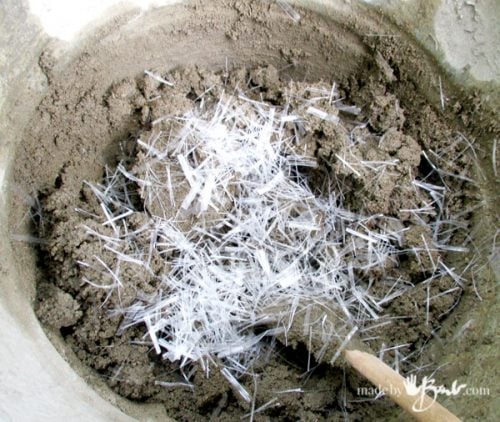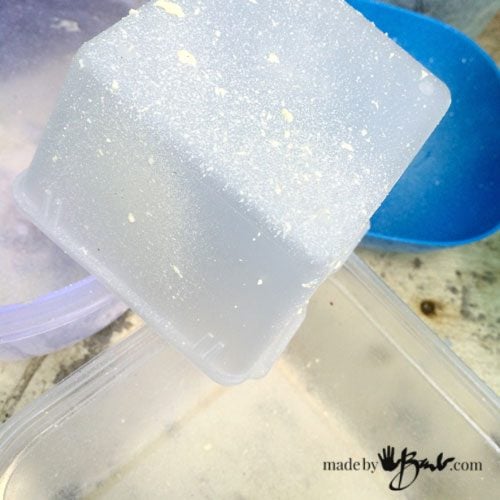Easy Poured Concrete Bowls
Lately this wonderful weather has meant more outdoor projects! You know concrete is one of my favourite mediums, and with the abundance of my garden lately, it just made sense to create some awesome bowls! Ok, I’ll admit, I hate to waste things so I had a bit (actually a lot) of ‘tupperware’ that was mismatched or missing lids. I knew I was saving it for something… You will love the beautiful shapes these Easy Poured Concrete Bowls can make in concrete!
If you have checked out my site you will see I have made quite a few concrete projects for my garden over the last 8 years. My stepping stones also use Quikcrete Sand Topping mix and I have found that they last really well, so I used it again. My concrete orbs used Portland cement. I also tried mixing sand with pure Portland cement, and found it to be quite the same as the topping mix, so save yourself the trouble and pick up (darn,it’s so heavy) a bag of Quikcrete for about $6-7.
You will need:
- Quikcrete Sand Topping Mix Concrete (like this)
- OPTIONAL Polypropylene Concrete Fibers (like this)
- Water
- Mixing Container & Utensil (shovel, spoon etc)
- Rubber gloves and Dust mask
- Variety of containers that fit inside each other comfortably.
- Some stones or like for weight
- Some release Agent like ‘Pam’ cooking spray or other grease.
Step 1:
Get set up so you have everything handy. Mix up your concrete by first adding the ‘Quikcrete’ to the bucket. Add water very slowly and mixing. Stir to the bottom and corners. I like to do smaller batches, as I find them easier to mix. I tend to keep the mix at a somewhat drier mix. It should just hold in clumps not run like pudding. I then add a small amount of the fibers (optional), and mix again. The fibers are meant to reinforce the structure of the concrete since there is no metal etc inside the concrete. I would suggest larger bowls need more reinforcement. Mine were on the smaller side so they could have done without the fibers.
Mix again, to distribute the fibers evenly. The mix should not be leaching water.
Step 2:
Readying the containers. Make sure that the bowls and shapes are going to allow you to pull out the bowl. That means that the bowl needs to be wider at top than bottom and have nothing that obstructs it. Straight vertical edges do work but take more effort to pull out. It is also very advisable to have something that can flex a bit, but not to soft or it will bow out with the weight of the concrete. Dollar stores have a great variety as well. Spray the inside of the larger containers and the outside of the smaller ones. You don’t need much.
Step #3:
Plop some mix into the bigger of the containers and spread it around. You can use a gloved hand and push it against the walls. The trick to having concrete without bubbles is vibration. I have observed many ‘concrete guys’ working on driveways etc. There is a large vibrating stick that they use to get bubbles out. I just use my hand and slap the heck out the mix, and also slap (like trying to extremely burp a baby) the container. You can tap it on the ground as well. All these are doing the same thing, making air rise to surface.
Step 4:
Push the smaller vessel into the middle of the larger one. I sometimes like to add a bit of design by turning it askew, or even sloped. Let your imagination go wild. Again, I wriggle it to get any trapped air out and fill the voids with mix. The more you wriggle, the concrete levels itself. I used to try a wetter mix, but then too much water rose to the surface, which is what concrete does, so I started working a bit drier.
See here, they are all nestled and I have added the rocks to weigh down the centers.
‘Concrete guys’ work the surface after it has set for a bit. They trowel and brush it to work the out the water and disperse it. I used a small brush to do the same.
Step 5:
Leave it somewhere out of the direct sun if possible. Now wait… It takes some time to set properly, about 24 hours.
Step 6:
Once it’s set and no longer wet on the surface, gently pull out the centers. Then invert over your hand and let the bowls fall into your hand. If stubborn, slightly flex the form.
Step 7:
Optional. You may be happy and leave them this way, or further perfect them. These showed uneven surface colour since I had not discovered the brushing technique at that point.
Step 8:
Being a gal with her own power tools, I save my elbow grease and use power. Caution though! Use a mask as concrete dust is nasty nasty stuff! I use aluminum oxide discs on a drill sanding rig. I’m not over obsessed with the sanding, just evening out the surface colour.
Step 9:
Concrete leaches out chemicals that are not that friendly with plants. Also concrete loves to cure slowly and be wet to gain strength. I pile the bowls in a big bucket for a few days and change the water daily. The first day, the water is quite ‘soapy’. Once drained and dry, they will be a nice light gray colour.
 Step 10:
Step 10:
If you need some ideas for finishing see my post here. Get mixing… And collecting succulent plants… For more concrete bowls or even Polyhedron Concrete

















Hi! I’m trying to figure out an approximate cost if I was to make candle holders using this method and product (they’d be either 2″ tall or 4″ tall and approximately 3.5″ diameter). There’s a 55lb bag for about $10 at the hardware store near me. Can you help me make a guess as to the approximate price of a 4″ candle holder? I’m not sure how much cement it would use from the bag. Thanks!
You would be able to make soooo many! Each would be cents. You time is the deciding factor I am sure. If you are good at math you could measure the volume of your mold and then compare to the volume it states on the bag. Go for it!
I really like your inspiration. Fun fact: instead of the “maxi slap”, put an electric sander against the side and and that will help with removing air bubbles.
Good idea, I am just usually a bit far from power. And I hate having to put so much equipment away, as impatience is my middle name. As you can see in these, even less finishing steps. Happy making!
Thank you. This is exactly what I’ve been searching for. I do have a question, when would you use straight portland cement and water (without the sand)?
I use straight portland cement when doing draping as then the fabric is the aggregate. Have fun!
Barbmaker. Beautiful work. Thank you for sharing with us how to do those beautiful pots and other cement art. I learn a lot from your website. I’m making now big balls using exercise balls. I bought Quikcrete sand topping concrete. . You are suggesting to mix with concrete fibres for big balls it is another option to use fibres? Thank you for great instructions. Take care
The sand topping mix is not strong enough for the big orbs. You can try but I don’t think it has the strength at a very thin thickness. It works great for the bowls and stepping stones I used the Sakrete Top’n Bond for some as well as Rapidset Cementall This post may help with the orbs as it is important to use the right mix since they are hollow. This post compares mixes. Concrete is fun…
How long does it take for concrete to dry after soaking it in water for a few days? I would like to paint my bowl. Also, is there anything I should seal the paint with to make it last longer?
The concrete will already be cured, as it doesn’t really just dry. The moisture in the concrete should evaporate out. Make sure it feels dry so that the paint will not be pushed off. Concrete likes to breathe, so a less solid layer will stay better. The accents hold better than full coverage. ‘Hope that helps!
This is so incredible Barb! I can not wait to try this out! You are so talented and amazing! I hope that my bowls come out the same way because I am in love. Keep posting awesome stuff!!
Good luck, keep an eye on the bowl mold shapes for easy removal. Flexibility helps!
Love your work. These concrete planters have been on my TO-DO for a while. Lovely.
The mix used is quite inexpensive and they have lasted really well out in the elements. You’ll keep looking at plastic containers in a new light…
Help me on what to put on a owl are what ever for outside what can I put on it to keep paint from coming are fading
If you really want to paint it, an exterior acrylic is advised. I prefer to not paint concrete as it usually does fail and need to be redone, just like houses need to be painted.